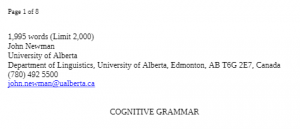PDF #22 – Cognitive Grammar
Fundamental to CG is the idea that language is an integral part of human cognition and cannot be properly understood without reference to cognitive abilities. A pervasive feature of Cognitive Grammar is the determination to reconcile accounts of linguistic structure with what is known about cognitive processing in domains other than language. CG contrasts in this respect with models which insist upon a discrete, autonomous “grammar module” and the Autonomy of Syntax.

Fundamental to CG is the idea that language is an integral part of human cognition and cannot be properly understood without reference to cognitive abilities. A pervasive feature of CG is the determination to reconcile accounts of linguistic structure with what is known about cognitive processing in domains other than language.
CG contrasts in this respect with models which insist upon a discrete, autonomous “grammar module” and the AUTONOMY OF SYNTAX. The cognitive orientation of CG is apparent from a reliance on notions such as sensory imagery, perspective, mental scanning, attention, and figure vs. ground asymmetry in accounting for linguistic phenomena. In broad terms, grammatical structure is explained as conventional imagery, with alternate structures reflecting alternate construal’s of the conceived situation.
Not surprisingly, the cognitive notions assume a relatively abstract interpretation when applied to some aspects of linguistic structure. For example, cognitive processes such as registration of contrast, scanning of a field, and perception of a boundary are all deemed relevant to explicating the notion of a count noun, understood as a “bounded region in some domain” in Langacker (1987, 189-203).
Such processes may be obvious factors in the conceptualization of nouns with clear spatial boundaries (e.g., cup, pencil), but a more abstract interpretation of these processes is clearly required in other domains. Body part nouns (e.g., waist, shoulder, side), for example, must be explicated in terms of a “virtual boundary” which does not correspond to any visible, objectively identifiable demarcation.
Likewise, the notions of figure and ground familiar from the study of perception are seen as underpinning various relational asymmetries in language. These notions have most obvious relevance in the case of words relating to the spatial domain, such as the contrasting pair above and below, where there is a kind of figure-ground reversal of the conceptual reference point.
The terms “trajector” (an extension of the notion of figure) and “landmark” (an extension of the notion of ground) are used to refer to the specifically linguistic manifestation of the perceptual notions of figure and ground, such that the book is the trajector and the table is the landmark in the book under the table. Conversely, the table is the trajector and the book is the landmark in the table over the book. More abstractly still, the traditional syntactic contrast between subject and object is construed as a very specific instance of the trajector vs. landmark contrast.
Make sure to visit our PDFs section and out social medias that are at the bottom of the homepage. To know more about my honest opinion on Worksheets you can visit my YouTube channel.
